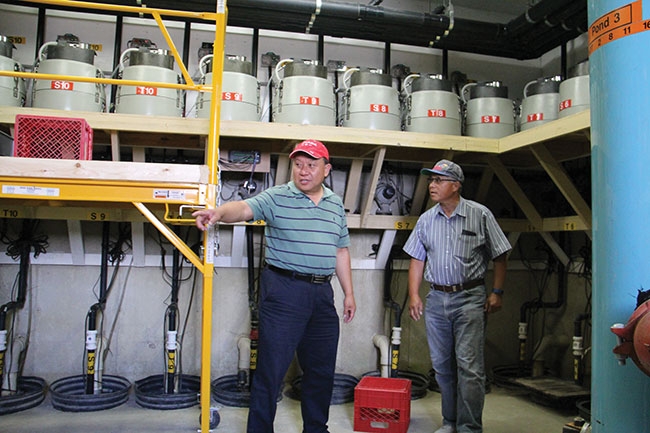
Features
Fertilizer
Seed & Chemical
Impacts on P loss
A new publication out of Agriculture and Agri-Food Canada’s (AAFC) Harrow Research Station shows that use of solid manure reduces particulate and total phosphorus (P) loss on tile-drained soil over time, compared to liquid manure and chemical fertilizer.
September 20, 2018 By Julienne Isaacs
 Tiequan Zhang (left) and Chin Tan (right) conduct semi-annual inspection for the auto-field water discharge monitoring and sampling systems. The state-of-the-art systems run continuously year-round with a back-up generator installed to ensure complete collection of quality data. Anew publication out of Agriculture and Agri-Food Canada’s (AAFC) Harrow Research Station
Tiequan Zhang (left) and Chin Tan (right) conduct semi-annual inspection for the auto-field water discharge monitoring and sampling systems. The state-of-the-art systems run continuously year-round with a back-up generator installed to ensure complete collection of quality data. Anew publication out of Agriculture and Agri-Food Canada’s (AAFC) Harrow Research StationTiequan Zhang, a research scientist focused on soil fertility and water quality, heads the long-term study with water management researcher Chin Tan in Woodslee, Ont. The paper, which was published in the Journal of Environmental Quality, includes data from 2008 to 2012, but the study continues, Zhang says.
“For this study the long-term aspect is really important because P dynamics and transformations in the soil with manure application is a very slow and cumulative process,” he says.
Funded through AAFC A-base funding, the study was designed to be as comprehensive as possible, looking at soil P cycling and losses within the whole ecosystem, so that Zhang and Chin can try to give a complete picture of impacts on crop production and water quality to farmers and regulators.
The experiment was set up in a randomized block design with two replicates. Treatments include combinations of two water
table management practices – free drainage versus controlled drainage with subirrigation – with four types of P fertilization: inorganic P fertilizer, liquid cattle manure, solid cattle manure, and soil P draw-down. A tile-drained buffer strip between each plot prevented contamination. Data on liquid and solid cattle manure with regular free drainage were reported in comparison with chemical fertilizer in the publication.
A corn-soybean rotation was planted on the plots. Tile water from each plot was delivered to a collection sump inside a monitoring station for automatic sampling and flow data collection.
According to Zhang, it is important to study a variety of types of manures, because producers use different types but also because each type of manure contains its own types of phosphorus.
“Phosphorus loss is driven by both the content and the form of the phosphorus,” he explains. “P loss can be different between liquid and solid manures, even though the same rates are applied.”
The researchers also applied the liquid, solid and chemical fertilizers based on P content, versus the conventional approach, which is to apply these fertilizers based on the crop’s nitrogen fertilizer needs – a practice that often results in over-applying P.
What they discovered at the end of the four-year period was that liquid manure increased dissolved reactive P loss immediately after application. But solid and liquid manure exhibited similar rates of dissolved P loss to IP fertilizer over the long-term. Liquid cattle manure and IP fertilizer showed roughly similar rates of particulate P loss during the four-year period, but solid manure reduced particulate P and total P loss over the long term.
Zhang says the results show solid cattle manure is preferable to reduce overall P losses. It’s also preferable for other reasons: solid manure has fewer pathogens than liquid manure, which means it’s safer for those applying it, and results in fewer pathogens and microorganisms making their way into water bodies.
If producers must use liquid cattle manure instead of solid cattle manure, there are methods to reduce P losses, such as applying several days before rainfall events are expected and cultivating the soil immediately after application. “This helps the P react with the soil components, and losses will be reduced,” Zhang says.
While limiting P losses is common sense both from economical and environmental standpoints, it isn’t the law. Ontario’s Nutrient Management Act was passed in 2002, but hasn’t been enforced due to a lack of scientific data. Instead, it offers recommendations to limit P losses. Zhang’s research helps bolster the needed data, and it also offers support to the Fertilizer Institute’s conventionally accepted 4R approach (right source, right rate, right time, right place).
Such an approach is especially necessary in Ontario, where about 63 per cent of cropland is under tile drainage. “According to our research, P loss from tile drained fields accounts for up to 85 per cent of total P loss. Tile drainage is a major path of P losses.”
Because tile drainage is unavoidably part of agriculture in Ontario, producers should look to research to help them apply P at rates that benefit crops but limit harm to the environment.